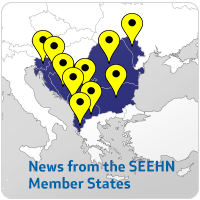
March 12-13, 2014, Jahorina, BiH
Following the Brussels Coordination Meeting (January, 2014), the RCC organized a SEE 2020 Coordination Meeting in Jahorina, Bosnia and Herzegovina. The meeting was attended by the SEEHN Presidency, Executive Committee members and the SEEHN permanent Working Group on SEE 2020 Strategy.
The purpose of the meeting was to discuss and agree on the SEEHN obligations and actions for SEE 2020 Strategy implementation, including on the:
- Monitoring of SEE 2020
- Implementing SEE 2020 through flagship initiatives
- Governing the implementation
- Work plan (2014 – 2019) of the health dimension objectives and measures under the Inclusive Growth pillar of the SEE 2020 Strategy
- Immediate needs in 2014 under the Presidencies of Romania and Republic of Serbia (Revisions of SEE Health Network basic legal documents; Concepts for the Fourth SEE Ministerial Forum; Next steps and timetable in 2014 and 2015)
Given the importance of monitoring of the implementation of the SEE 2020 Strategy, the meeting paid special attention to discussing and revising an OECD proposed set of measurable quantitative indicators for the health dimension. Having in mind the “health in all policies concept”, the health targets and indicators were restructured in order to fully align health prevention and promotion with it, while also having in mind the social determinants of health and inequalities. Agreeing on a revised set of quantitative indicators was one of the major outcomes of this meeting, and a first and very important step towards devising the full monitoring framework. The next step for completing this framework is to devise a set of qualitative indicators, which will follow later in 2014. A revision and further development of the flagship initiatives will also follow in the coming months.
Table 1: Proposed outcome and policy quantitative health indicators of the SEE2020 Strategy (Jahorina)
|
OUTCOME MEASURES & Data Sources |
Indicators of Impact by 2020 & Data Sources |
Annual Progress Measure & Data Sources |
Health Activities |
| Continued increase in life expectancy at current rate as (2006-2010)
% increase in healthy life years at age 65 % reduction in low birth weight % relative annual reduction in age-standardized overall premature mortality rate (from 30 to under 65 years) for four major noncommunicable diseases (HFA-MDB)
% Increase universal coverage % reduction in infant mortality per 1000 live births (HFA-DB) |
|
|
|





